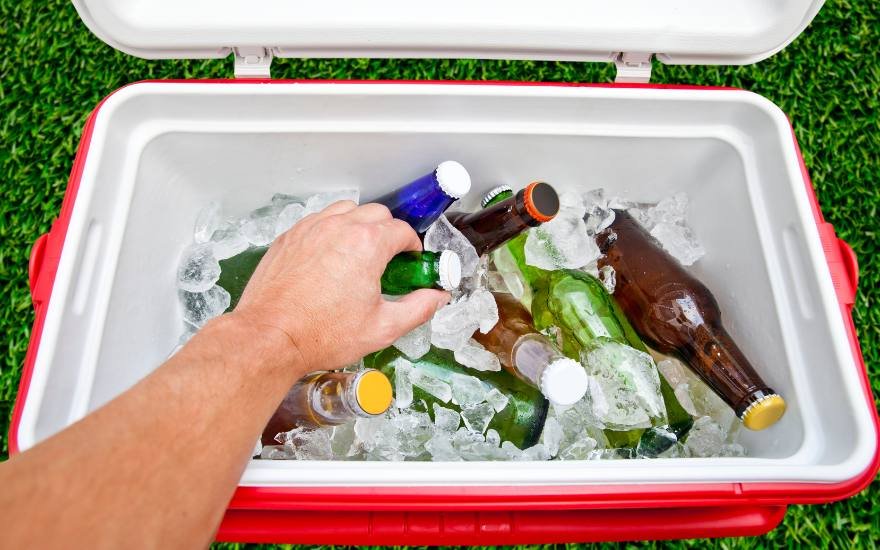We don’t get much sun in the UK, so when it does finally arrive, we’ve got to make the most of it. One way is to know that whilst you’re shutting your eyes and taking in those glorious rays, at a picnic, or the beach or a festival, you’ve got an ice-cold drink and chilled lunch waiting for you.
Coolers come in many forms these days. There are your classic blue and white beach caddies, insulating backpacks, electric active cooling boxes and more. There are also massive price fluctuations, which depending on your budget and specific need for a cooler, may or may not be worth it.
All of our cooler suggestions below are well-reviewed and will definitely keep your food and drink reliably chilled, but each one specialises in a certain area. Summer is here, and who knows for how long, so let’s elevate summer outings with the perfect cool box for you.
Best Value Cooler
Coleman Xtreme Cooler
With its classic design, Coleman are a great provider of no nonsense coolers that won’t let you down and don’t cost a bomb. This is one of their smallest coolers, with 47L, 66L and even larger all available. At just over 2kg, it’s also relatively easy to carry on shorter walks, into festivals etc. It’s slim but pretty tall at 47cm, so tucks away conveniently in the car, and can be used as a seat or even a table with four slots for drinks in the corners. It’s a really well-made cooler with sturdy handle and grips, and it’ll comfortably keep your beverages cool for over a day.
Capacity: 26L
Empty weight: 2.1kg
Find here: £60 (usually more!)
Best Portable Cooler
Quechua Decathlon Isothermal Backpack
Quechua is a reliable brand available at Debenhams, and this 25L backpack is a fantastic compromise between reliability, weight and portability. They have a few different sizes, from a smaller, cheaper 10L model up to a 30L backpack, but this is a really well-reviewed, consumer-tested compromise. Perfect for hikes or long days out, it keeps food and drinks cool for up to 7 hours with no ice packs. It makes it easy to keep bottles upright, includes an outer zipped pocket for keeping belongings separate and two further mesh pockets as well. Everything’s adjustable for comfort so all in all, it’s a super solid, decent-sized cooler backpack.
Capacity: 20L
Empty weight: 480g
Find here: £27.98
Best Bottle Cooler
CaddyO Bottle Chiller
Of course, we have a special focus on drinks gadgets here, so want to shout out this bottle chiller for the times when food isn’t on the menu, and you just require one special bottle. The bottle carrier is placed in the freezer for at least four hours, which means that when the time comes to place your bottle in it, the unique cooling gel begins to actively chill the liquid. This then goes inside the neoprene cover to insulate everything and make it easy to carry. It works for 750ml and 1L bottles so that’s mainly wines and spirits. You can expect up to 9 hours of chill! Nice bit of kit.
Capacity: 1 750ml or 1L bottle
Empty weight: 550g
Find here: £50
Best Reliable Cooler
YETI Hopper Flip 18 Portable Soft Cooler
This cooler will get you through anything. The DryHide shell is hard as nails, being completely waterproof and capable of standing up to abrasions and punctures. Crucially, the hardy zipper is made to last pretty much forever, so much so that it’s even a little difficult to open – but that’s just a reminder of its security. YETI’s flagship dedication is to the cooling itself, and thanks to ColdCell foam insulation here, this is no ordinary soft cooler, able to chill the contents for not hours but days! It looks fantastic and comes in many different stylish colours, and whilst their 18 is the biggest, they also offer smaller, cheaper coolers.
Capacity: 25L
Empty weight: 2.3kg
Find here: £299.99
Best Dual-Purpose Cooler
ProCook Insulated Picnic Backpack
This backpack is everything you need for a stellar picnic. Despite having no foil, the 15L insulated section does a great job and keeping food chilled – possibly not for as long as others, but certainly enough for several hours. Round the front is a front pocket, which includes a nicely laid out set of cutlery for four, a bottle opener and a chopping board. The classic, beachy design is stylish too.
Capacity: 15L excluding additional compartment
Empty weight: 1.6kg
Find here: £34.99 (usually more!)
Best Active Cooler
Halfords Electric Coolbox
Most cool boxes are ‘passive’, which means their promise to you is to retain the temperature of the stuff you put in it. So, if you pop in a room temperature beer, it won’t be warm a few hours later, but it certainly won’t be chilled. For that, you need an active cooler like this. This beast can hold 56 standard 330ml cans and comes with temperature controls. Of course, it needs power, so it needs plugging into the mains or into a car lighter (you get two cables with it). If you’re on a long road trip it could go on the backseat, or it’s suitable for motor home travels or campsites. At 8.4kg, you don’t want to be lugging it around but if you don’t want ice but need drinks and food to be properly chilled on the move, it’s a great bet.
Capacity: 40L
Empty weight: 8.4kg
Find here: £95 (usually more!)
If you want to make some cocktails for your summer outings, check out these handy picnic mixes!












































